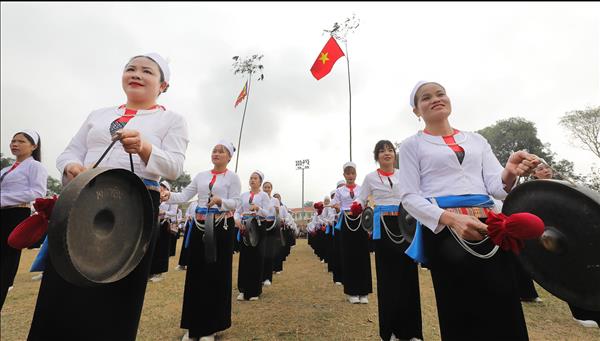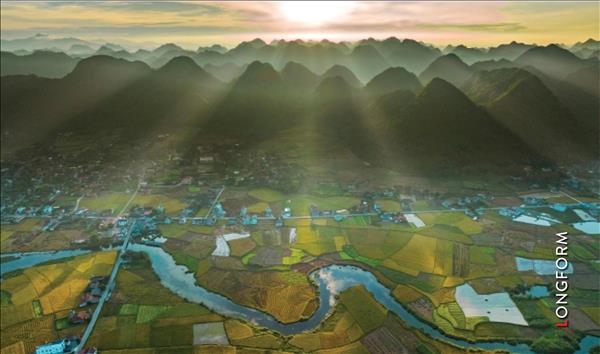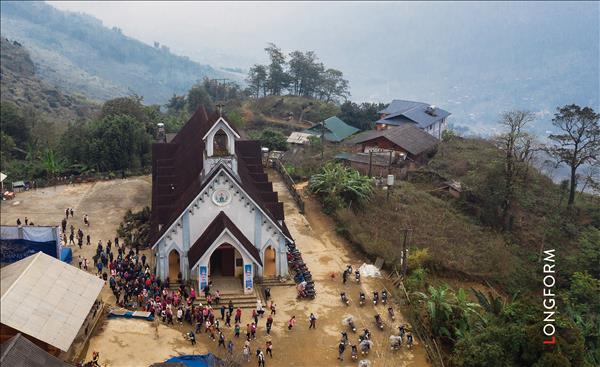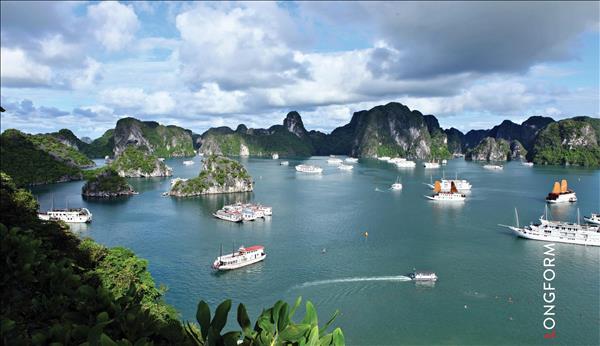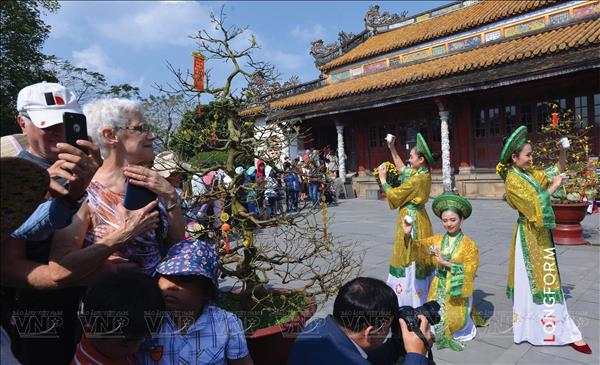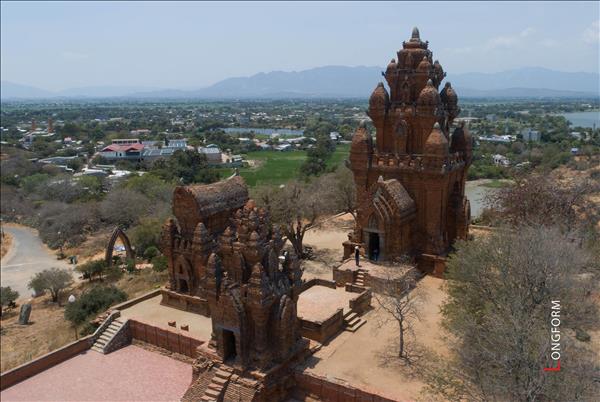The Marvellous Changes on Moc Chau Plateau
Son La Province has been famous for Moc Chau Plateau which is considered “Da Lat of the northwest”. More than ten years ago, Moc Chau highlanders, largely Thai, Si La and La Ha ethnic groups, led a hard life. Being migrants from the reservoir area, they did not know how to plant green tea and raise milk cows. Some scientists, during their surveys, had to cry out: “Moc Chau has super-firewood tea and super-boney cows”, meaning the tea grown by people yielded only firewood and the cows raised by people were scraggly with skin clinging to the bone.
Not losing heart, Moc Chau administration and people step by step organised different courses on tea-planting and milk cow raising techniques and methods and capital was supplied for every hamlet. After many years of firmly sticking to their undertaking and overcoming untold difficulties, their work bore fruit with many brands of Moc Chau such as Shan Tuyet tea, Moc Chau O Long tea, and Moc Chau milk now seen in various big stores nationwide.
We called on the family of Deo Van Nam, the Thai ethnic group, that we had a chance to visit in 2004 after he had just migrated to Moc Chau from Quynh Nhai. He now owns vast tea hills stretching far to the horizon and herds of fat milk cows grazing on the green steppes.
Meeting old acquaintances again, Nam said, “Moc Chau is truly a good land. If the growing and tending process is strictly observed, plants of every kind can blossom and bear fruit”.
What Nam said reflected a much better life of Moc Chau inhabitants at present. Located not far away from Nam’s house is a milk cow farm of Lam Thanh Tran nicknamed “King of Moc Chau milk cow”. Just like Nam, he also started up his business with numerous difficulties and hardships. Now he owns 30 milk cows, which annually yield about 200tonnes of milk with a revenue of more than 1.5 billion dong, a dream even for people living in Hanoi.
That afternoon, we followed Tran to the milk-purchase location, accidentally meeting Tran Cong Chien, General Director of Moc Chau Milk-Cow Breed Joint-stock Company, who was on tour to examine milk quality. He said that at present his company is raising more than 5,000 milk cows of Australian, American and Dutch breeds, which are giving milk. In a short-term plan towards 2020, the company will turn Moc Chau into the largest milk-cow area in Southeast Asia. To this end, he cheerfully added, “we must make 100% of the milk cow farmers in Moc Chau ‘kings of milk cow’ like Tran here”.
Present-day Moc Chau is not only the land of “super-bud tea and super-milk cows” but also a favourite investment location of many domestic and foreign enterprises. The Takii Seed Vietnam Company Ltd., is a typical example, which was the first foreign company to invest in Moc Chau. The Company Director, Nobuyuki Toyama, said Moc Chau is not only endowed with a temperate climate and fertile soil, but also has open investment policies. For such reasons, he chose this region to build a company specialising in the production of high-quality plant varieties. So far, Takii Seed Vietnam Company has successfully produced seeds and sent them to its parent company in Japan to supply to countries with first world-ranked agriculture such as Australia, the United States and Russia.
With the above advantages, in 2014, Moc Chau was chosen by the Government to be turned into a national tourist area. Under the planning, the national tourist zone of Moc Chau, when in operation, will serve as the driving force for the tourist development of Son La and other northern mountainous and midland provinces, with diverse and distinctive tourist products associated with natural landscapes and cultural identities of various ethnic groups.
Epic of Northwestern Region’s Rivers and Waterways
Twelve years ago, we made an odyssey on the Da River with a commercial fleet carrying kitchen salt, rice and dried fish from Quynh Nhai District (Son La Province) upstream to Muong Lay provincial town in Dien Bien Province. The trip left me with unforgettable impressions of the primitively wild Da River with numerous waterfalls and whirlpools, creating a marvelous view.
Returning to Quynh Nhai this time, we are surprised by the great changes here. Dieu Chinh Hien, Deputy head of Quynh Nhai District’s Culture Department, said: “ It would be a waste of time if you failed to travel on the reservoir of Son La Hydroelectric Power Plant this time”. The following day, he took us to Pa Uon Wharf for sightseeing by boat on the reservoir which gradually emerges as immense, primitively wild and stunningly beautiful amidst the surrounding high mountain ranges of Pha Muong, Pha Lan and Pha Din to its left and Pu Lech and Pu Lao with Tang Khe peak of 2,020m high above sea level to its right.
Acting as a tourist guide, the Culture Department official told us that since the Son La Hydroelectric Power Plant was put into operation, this reservoir has become an extremely beautiful tourist destination beyond the expectation of anyone, with numerous islets.
Son La reservoir is one of five giant man-made lakes in the northwestern region. Only in the reservoir section which is 30km long in Quynh Nhai District, there appear to be hundreds of islets named by local people according to their rich imagination such as Con Coc (Toad) Islet; Con Ga (Rooster) Islet, Ong Tien (Fairy) Islet, and Phuong Hoang (Phoenix) Islet.
At dawn, when the sun appears behind Tang Ke Mountain peak, the Thai ethnic people living around the reservoir start a new day, laying cylindrical bamboo fish-pots and fish-traps under the misty water surface.
At nightfall, the reservoir surface glitters with stars falling from the lamps of offshore fishermen. The Thai people in Quynh Nhai catch shrimp and fish in the reservoir in their own way. When night falls, they cast nets of about 30-50m2 into the reservoir and burn lamps to lure the fish.
When arriving here, many tourists usually opt to stay overnight on the reservoir with Thai fishermen in order to discover their interesting way of fishing and can taste fresh shrimp and fish, the specialty of Da River when they wake up in the morning. At night they can hear mysterious stories told by fishermen about two “aquatic monsters”, namely hemibagrus and sturgeon, which weigh hundreds of kilograms each and are able to kill even a big buffalo. Whether they are true or not, such stories always inspire visitors, igniting their curiosity to discover.
During a leisurely trip on the reservoir, Dieu Chinh Hien took us on a visit to Sa Thu fish farm of Luong Van Ngoa with 16 cages for raising different kinds of fish such as hemibagrus and carp and especially sturgeon in eight cages. The farm owner revealed that this rare species of sturgeon have been reared in the reservoir by many families. His own family sells each year some 60tonnes of sturgeon at the price of about 600,000 VND/kg.
At present, aquaculture has developed rather strongly in the communes of Chieng On, Chieng Bang and Muong Chien of Quynh Nhai District. In Chieng Bang Commune alone, the aquaculture area has reached 72ha, with 155 fish-rearing cages and the participation of more than 100 households.
It is known that Quynh Nhai District in particular and Son La Province in general is expeditiously undertaking the task to develop the reservoir economy and tourism. Dieu Thi Dan, Vice President of Quynh Nhai District People’s Committee, said her district has coordinated with Sin Ho District of Lai Chau Province and Muong Lay District of Dien Bien Province in conducting surveys and formulating the scheme for a reservoir tourist route.
Under the scheme, such a tourist route will stretch 120km with the first destination, Quynh Nhai District and the final destination, Muong Lay District of Dien Bien Province. On that trans-northwestern region route, tourists will have a chance to discover the beauty of primitive wild rivers and majestic misty mountain ranges as well as the life deeply imbued with the cultural identities of Thai, Kho Mu, Dao, La Ha, Khang, Xinh Mun and Mang ethnic minorities and extremely beautiful lake-side hamlets.
Son La Province has been famous for Moc Chau Plateau which is considered “Da Lat of the northwest”. More than ten years ago, Moc Chau highlanders, largely Thai, Si La and La Ha ethnic groups, led a hard life. Being migrants from the reservoir area, they did not know how to plant green tea and raise milk cows. Some scientists, during their surveys, had to cry out: “Moc Chau has super-firewood tea and super-boney cows”, meaning the tea grown by people yielded only firewood and the cows raised by people were scraggly with skin clinging to the bone.
Not losing heart, Moc Chau administration and people step by step organised different courses on tea-planting and milk cow raising techniques and methods and capital was supplied for every hamlet. After many years of firmly sticking to their undertaking and overcoming untold difficulties, their work bore fruit with many brands of Moc Chau such as Shan Tuyet tea, Moc Chau O Long tea, and Moc Chau milk now seen in various big stores nationwide.
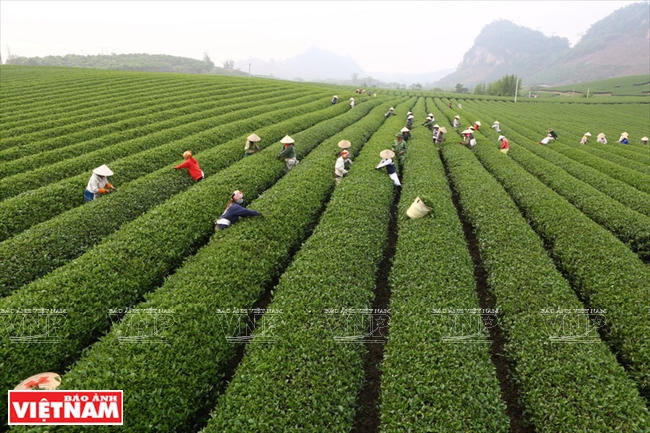 The locals raise a variety of fish, such as carp and sturgeon in the Son La reservoir. Photo: Viet Cuong/VNP 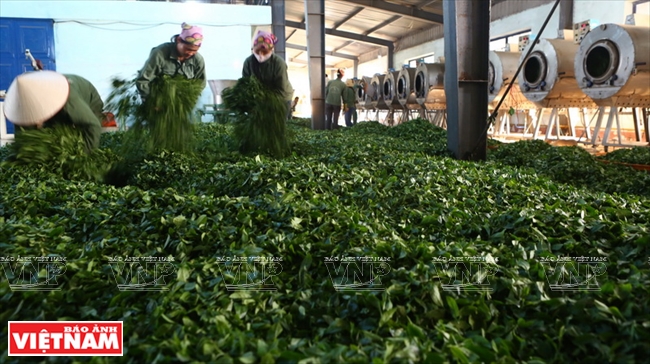 Workers classify tea before processing it at the Co Do Tea Company. Photo: Thong Thien/VNP |
| Moc Chau District has developed 1,822ha of tea, largely in five communes and townships. So far, 10 companies or enterprises of China and Taiwan have registered for tea production and trading. |
Meeting old acquaintances again, Nam said, “Moc Chau is truly a good land. If the growing and tending process is strictly observed, plants of every kind can blossom and bear fruit”.
What Nam said reflected a much better life of Moc Chau inhabitants at present. Located not far away from Nam’s house is a milk cow farm of Lam Thanh Tran nicknamed “King of Moc Chau milk cow”. Just like Nam, he also started up his business with numerous difficulties and hardships. Now he owns 30 milk cows, which annually yield about 200tonnes of milk with a revenue of more than 1.5 billion dong, a dream even for people living in Hanoi.
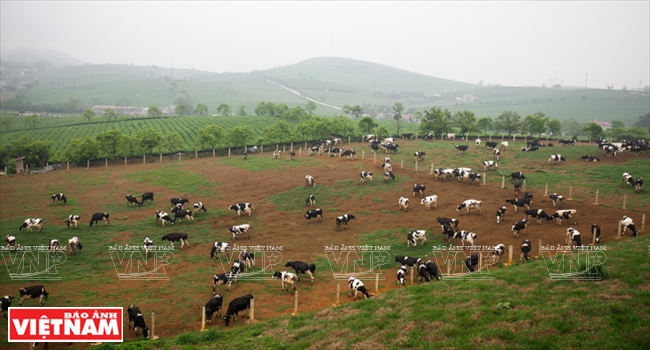 Moc Chau District has developed a herd of 5,000 dairy cows and plans to become the largest dairy cow raising area in Southeast Asia by 2020. Photo: Viet Cuong/VNP  The advanced milking of the Moc Chau Dairy Cattle Breeding Joint-stock Company (Moc Chau Milk). Photo: Trinh Bo/VNP 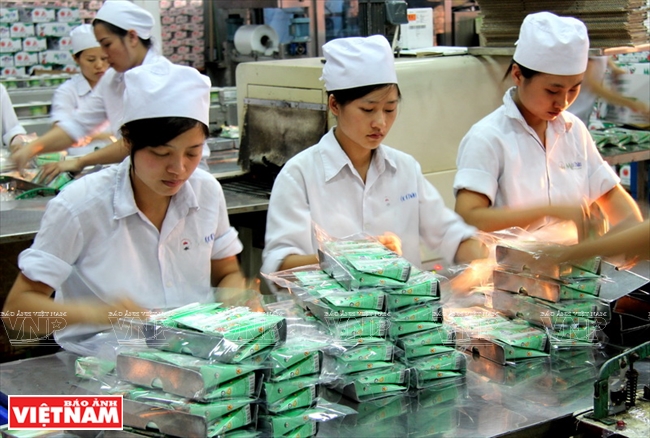 Packing products at Moc Chau Milk. Photo: Trinh Bo/VNP |
That afternoon, we followed Tran to the milk-purchase location, accidentally meeting Tran Cong Chien, General Director of Moc Chau Milk-Cow Breed Joint-stock Company, who was on tour to examine milk quality. He said that at present his company is raising more than 5,000 milk cows of Australian, American and Dutch breeds, which are giving milk. In a short-term plan towards 2020, the company will turn Moc Chau into the largest milk-cow area in Southeast Asia. To this end, he cheerfully added, “we must make 100% of the milk cow farmers in Moc Chau ‘kings of milk cow’ like Tran here”.
Present-day Moc Chau is not only the land of “super-bud tea and super-milk cows” but also a favourite investment location of many domestic and foreign enterprises. The Takii Seed Vietnam Company Ltd., is a typical example, which was the first foreign company to invest in Moc Chau. The Company Director, Nobuyuki Toyama, said Moc Chau is not only endowed with a temperate climate and fertile soil, but also has open investment policies. For such reasons, he chose this region to build a company specialising in the production of high-quality plant varieties. So far, Takii Seed Vietnam Company has successfully produced seeds and sent them to its parent company in Japan to supply to countries with first world-ranked agriculture such as Australia, the United States and Russia.
|
“Son La focuses on the development of agricultural products like tea, milk cows, plum (Moc Chau and Van Ho), mango, banana (Yen Chau) and Ta Xua tea (Bac Yen). In the coming time, the province will prioritise the development of storage technology and promotion of these agricultural products”. |
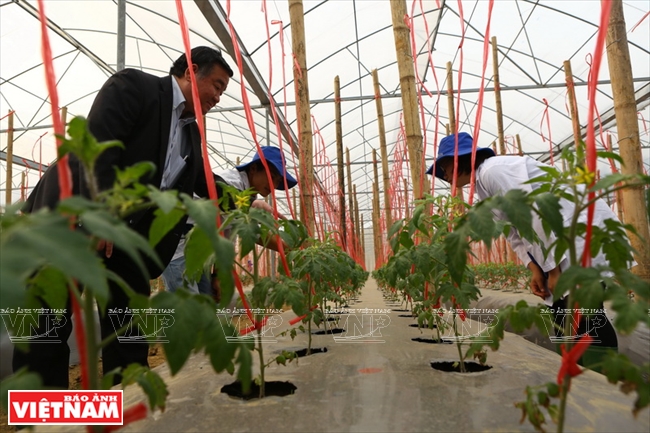 The tomato nursery of the Takii Seed Vietnam Co., Ltd in Dong Sang Commune, Moc Chau District. Photo: Thong Thien/VNP  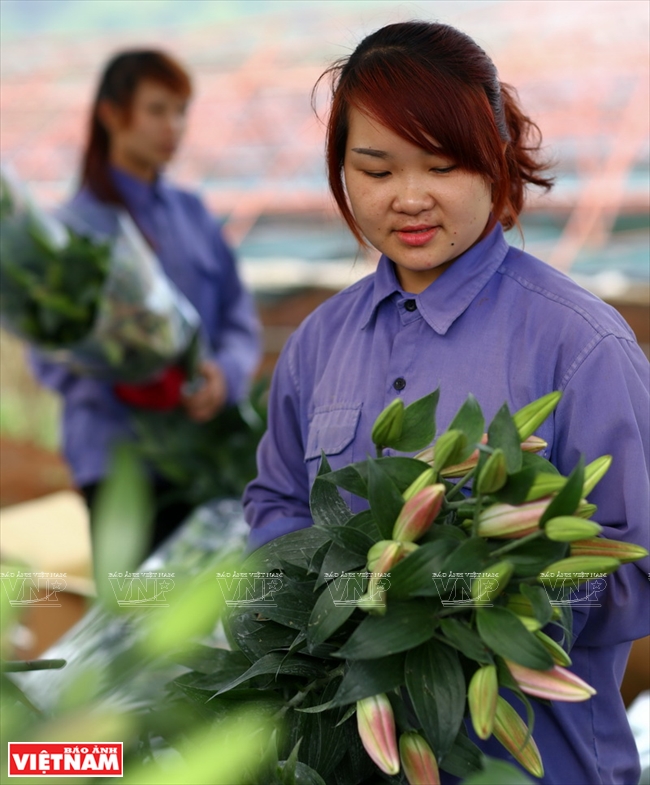 With a cool climate all year round, Moc Chau is an ideal place for growing strawberries and lily flowers that bring economic value to farmers. Photo: Thong Thien/VNP  There are many valleys of plum trees in Moc Chau which are favourite destinations for tourists. They include Van Ho and Loong Luong Communes in Van Ho District, the Farm Town and communes Tan Lap, Dong Sang and Muong Sang in Moc Chau District. Photo: Thong Thien/VNP 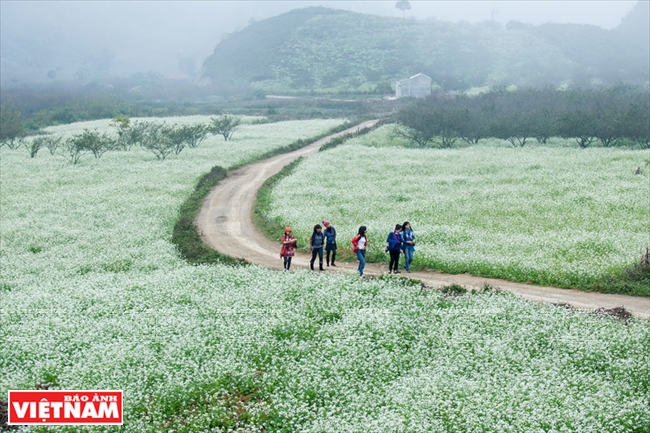 The season of white colza flowers which are planted for taking attar in Moc Chau Plateau. Photo: Viet Cuong/VNP 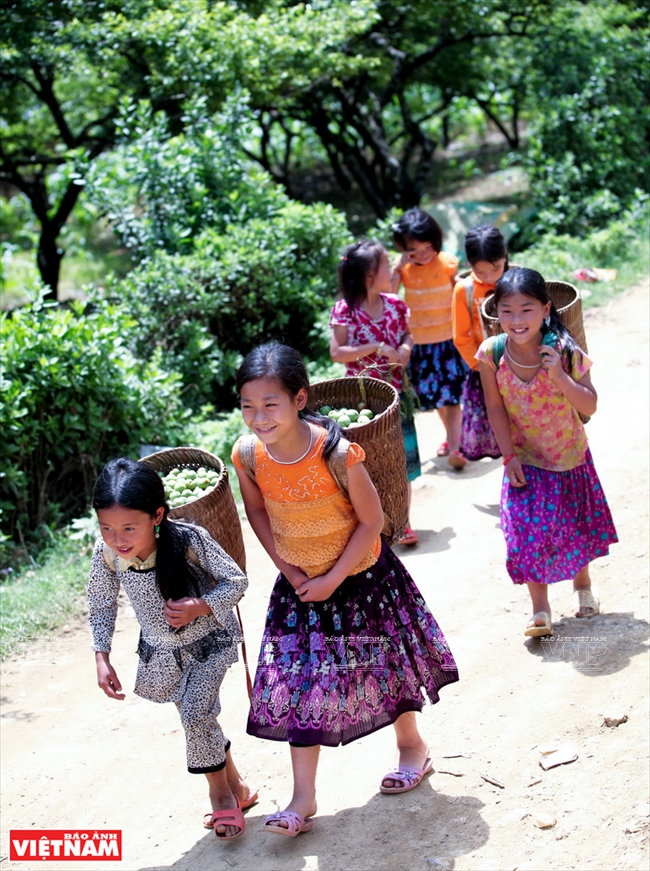 The Mong chidren carryy baskets of Tam Hoa plums. Photo: Viet Cuong/VNP |
With the above advantages, in 2014, Moc Chau was chosen by the Government to be turned into a national tourist area. Under the planning, the national tourist zone of Moc Chau, when in operation, will serve as the driving force for the tourist development of Son La and other northern mountainous and midland provinces, with diverse and distinctive tourist products associated with natural landscapes and cultural identities of various ethnic groups.
Epic of Northwestern Region’s Rivers and Waterways
Twelve years ago, we made an odyssey on the Da River with a commercial fleet carrying kitchen salt, rice and dried fish from Quynh Nhai District (Son La Province) upstream to Muong Lay provincial town in Dien Bien Province. The trip left me with unforgettable impressions of the primitively wild Da River with numerous waterfalls and whirlpools, creating a marvelous view.
Returning to Quynh Nhai this time, we are surprised by the great changes here. Dieu Chinh Hien, Deputy head of Quynh Nhai District’s Culture Department, said: “ It would be a waste of time if you failed to travel on the reservoir of Son La Hydroelectric Power Plant this time”. The following day, he took us to Pa Uon Wharf for sightseeing by boat on the reservoir which gradually emerges as immense, primitively wild and stunningly beautiful amidst the surrounding high mountain ranges of Pha Muong, Pha Lan and Pha Din to its left and Pu Lech and Pu Lao with Tang Khe peak of 2,020m high above sea level to its right.
Acting as a tourist guide, the Culture Department official told us that since the Son La Hydroelectric Power Plant was put into operation, this reservoir has become an extremely beautiful tourist destination beyond the expectation of anyone, with numerous islets.
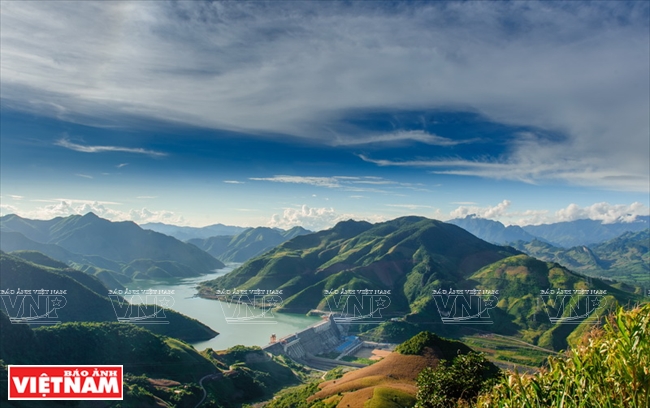 The Son La reservoir located in three provinces of Son La, Dien Bien and Lai Chau has a total length of 175km and a water surface area of 224km2. Photo: Le Hong Ha 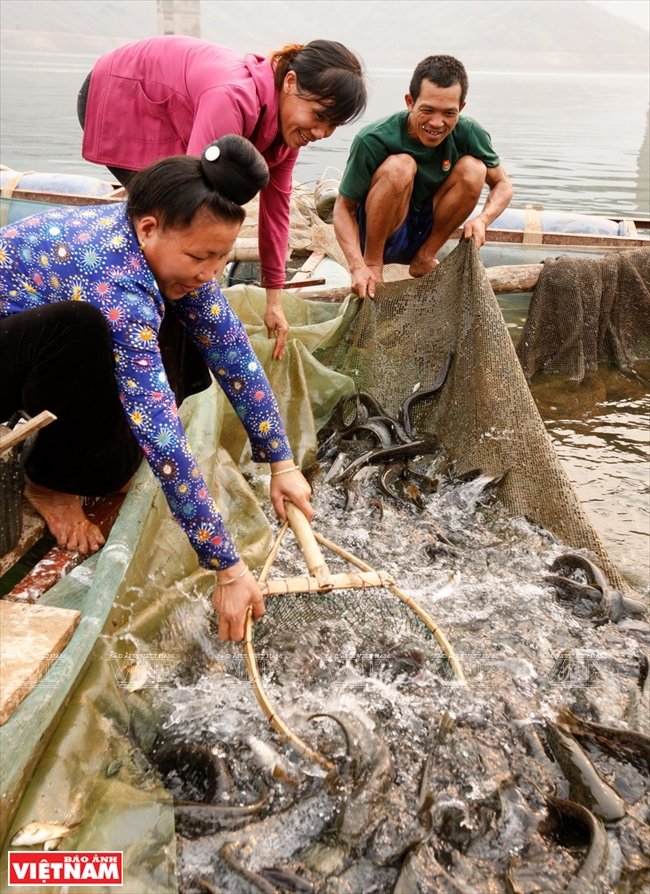 Vu Thi Hanh Loi (middle), Head of Hanh Loi Cooperative which specialises in raising hemibagruses, giant devil catfish and sturgeons at the foot of Pa Uon Bridge. Photo: Viet Cuong/VNP 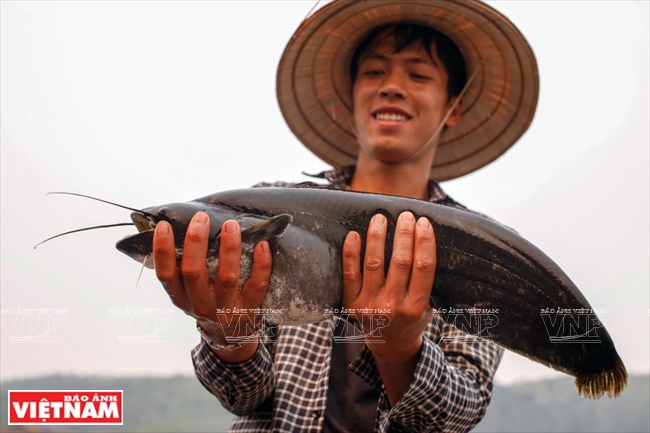 The locals raise a variety of fish, such as carp and sturgeon in the Son La reservoir. Photo: Viet Cuong/VNP  The family of Tong Van Hoa has developed a model of raising wild ducks on the Son La reservoir. Photo: Viet Cuong/VNP  The traditional boat racing festival of the Thai people in Quynh Nhai District. Photo: Dieu Chinh Toi |
Son La reservoir is one of five giant man-made lakes in the northwestern region. Only in the reservoir section which is 30km long in Quynh Nhai District, there appear to be hundreds of islets named by local people according to their rich imagination such as Con Coc (Toad) Islet; Con Ga (Rooster) Islet, Ong Tien (Fairy) Islet, and Phuong Hoang (Phoenix) Islet.
|
Son La Hydroelectric Power Plant’ s reservoir lies in the territories of three provinces of Son La, Dien Bien and Lai Chau. It covers an area of 224km2, 175km long and 1,7km wide, and can hold 9.26 billion m3 of water. |
At nightfall, the reservoir surface glitters with stars falling from the lamps of offshore fishermen. The Thai people in Quynh Nhai catch shrimp and fish in the reservoir in their own way. When night falls, they cast nets of about 30-50m2 into the reservoir and burn lamps to lure the fish.
When arriving here, many tourists usually opt to stay overnight on the reservoir with Thai fishermen in order to discover their interesting way of fishing and can taste fresh shrimp and fish, the specialty of Da River when they wake up in the morning. At night they can hear mysterious stories told by fishermen about two “aquatic monsters”, namely hemibagrus and sturgeon, which weigh hundreds of kilograms each and are able to kill even a big buffalo. Whether they are true or not, such stories always inspire visitors, igniting their curiosity to discover.
During a leisurely trip on the reservoir, Dieu Chinh Hien took us on a visit to Sa Thu fish farm of Luong Van Ngoa with 16 cages for raising different kinds of fish such as hemibagrus and carp and especially sturgeon in eight cages. The farm owner revealed that this rare species of sturgeon have been reared in the reservoir by many families. His own family sells each year some 60tonnes of sturgeon at the price of about 600,000 VND/kg.
At present, aquaculture has developed rather strongly in the communes of Chieng On, Chieng Bang and Muong Chien of Quynh Nhai District. In Chieng Bang Commune alone, the aquaculture area has reached 72ha, with 155 fish-rearing cages and the participation of more than 100 households.
It is known that Quynh Nhai District in particular and Son La Province in general is expeditiously undertaking the task to develop the reservoir economy and tourism. Dieu Thi Dan, Vice President of Quynh Nhai District People’s Committee, said her district has coordinated with Sin Ho District of Lai Chau Province and Muong Lay District of Dien Bien Province in conducting surveys and formulating the scheme for a reservoir tourist route.
Under the scheme, such a tourist route will stretch 120km with the first destination, Quynh Nhai District and the final destination, Muong Lay District of Dien Bien Province. On that trans-northwestern region route, tourists will have a chance to discover the beauty of primitive wild rivers and majestic misty mountain ranges as well as the life deeply imbued with the cultural identities of Thai, Kho Mu, Dao, La Ha, Khang, Xinh Mun and Mang ethnic minorities and extremely beautiful lake-side hamlets.
Story: Thong Thien
Photo: Viet Cuong, Thong Thien, Trinh Bo, Dieu Chinh Toi & Le Hong Ha
Photo: Viet Cuong, Thong Thien, Trinh Bo, Dieu Chinh Toi & Le Hong Ha

